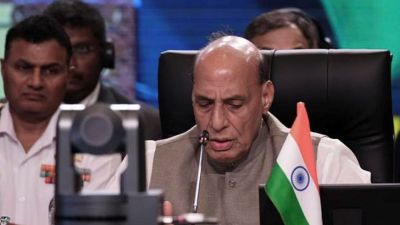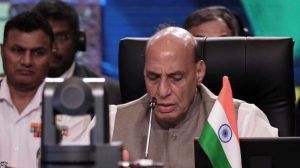Prime Minister Narendra Modi and US President Donald Trump on Thursday (early morning in Friday in India) announced plans to negotiate the first tranche of a mutually beneficial, multi-sector Bilateral Trade Agreement (BTA) this year, and to double bilateral trade between the two countries from the current $200 billion-level to $500 billion by 2030.
While a BTA, unlike a free trade agreement, is far narrower in scope and focuses on specific goods rather than overall trade liberalisation, New Delhi and Washington have committed to designating “senior representatives” to advance trade negotiations, according to the India-US joint statement. Both countries will work towards “increasing market access”, reducing tariff and non-tariff barriers, the statement added.

That said, barely hours before meeting Modi, Trump announced plans to impose reciprocal tariffs on all US trading partners, including India, “to restore fairness in US trade relationships” and correct “long-standing imbalances” in international trade. Trump has already imposed 25% tariffs on aluminium and steel, impacting Indian exports.
Story continues below this ad
While announcing reciprocal tariffs, Trump specifically mentioned India, saying that its tariff structure prevents American products, such as cars, from gaining access to the Indian market. He described this as a “big problem”, and indicated that the US aims to bridge the trade gap by boosting the sale of oil and gas to India.
What BTA might mean for India
This is not the first time India and the US have agreed to explore the possibility of a trade agreement.
However, the US-led 14-member Indo-Pacific Economic Framework for Prosperity (IPEF), of which India is a part, could not agree on the “trade pillar” of the IPEF in 2022 as it did not offer tariff reductions or increased access to the US market. Moreover, Trump during his first term stopped the Generalized System of Preferences (GSP) program that gave duty free access to over $5 billion worth Indian goods to the US.
Due to job losses in several areas — particularly the United States’ industrial belt following China’s entry into the WTO — sentiment among US lawmakers has turned against granting more market access to foreign goods. A paper by the US-based think tank National Bureau of Economic Research titled ‘Importing Political Polarisation and Electoral Consequences of Rising Trade Exposure’ (2017) stated that growing import competition from China has contributed to a shift to the right in the political beliefs of US adults. The paper also noted that in the 2016 presidential election, trade shocks increased the vote share of the Republican candidate — Donald Trump.
Story continues below this ad
Trade experts suggest that a BTA would likely require India to lower tariffs to allow greater entry of American goods, rather than the US reciprocating, as average tariffs in the US are already among the lowest in the world.
Think tank Global Trade Research Institute (GTRI) said this is not the best time for a trade deal with the US, as the current regime simply does not respect FTAs. This is illustrated by the Trump administration’s imposition of tariffs on Mexico and Canada on steel and aluminium “in violation of United States-Mexico-Canada Agreement (USMCA) provisions,” GTRI said.
Experts said that due to India’s generally higher average tariff levels compared to competing nations — and the fact that India has entered into fewer FTAs than many of its competitors — the trade margins that other countries secure in agreements are typically more favourable than what India secures.
A 2022 report by think tank Delhi Policy Group (DPG) highlighted that tariff imbalances were a key reason why ASEAN countries export more to India than they import from it.
Story continues below this ad
“The lack of a vibrant manufacturing sector has reduced India’s export capabilities, with manufactured goods exports dominated by low- to medium-technology-based products. To improve export potential, India needs to shift focus from low-tech or low-skill products, as it faces an incumbency disadvantage against low-cost producers in Asia,” an IIM Ahmedabad report in 2023 on India’s FTAs stated.
Pressure on US to reduce trade deficit
Even as India lowered its basic customs duty on a range of items in the Union Budget, a White House statement on reciprocal tariffs pointed out that Indian tariffs on agricultural goods and motorcycles remain significantly higher than those imposed by the US on Indian products.
“The US average applied Most Favoured Nation (MFN) tariff on agricultural goods is 5% while India’s average applied MFN tariff is 39%. India also imposes a 100% tariff on US motorcycles, whereas the US only charges a 2.4% tariff on Indian motorcycles,” the White House said.
CHART 1: India’s goods trade surplus with US has doubled over the past 5 years
|
| Year |
Exports to US |
Imports from US |
Surplus |
| 2023-24 |
77.52 |
42.19 |
35.33 |
| 2022-23 |
78.31 |
50.86 |
27.45 |
| 2021-22 |
75.6 |
43.31 |
32.29 |
| 2020-21 |
51.63 |
28.88 |
22.75 |
| 2019-20 |
53.11 |
35.81 |
17.3 |
| Value in $bn. Source: Commerce and Industry Ministry |
Regarding efforts to reduce the trade deficit with the US, Foreign Secretary Vikram Misri said that India is a significant purchaser of US energy, having bought some $15 billion worth of US energy output last year.
Story continues below this ad
“There is a good chance that this figure will rise to as much as $25 billion in the near future… and today’s discussions focused considerably on the possibility of increased energy purchases. It is entirely possible that these increased purchases will contribute to addressing the trade deficit between the two countries as well,” Misri said on Friday.
| CHART 2: Imports & exports from the US (2023-24) |
Top 5 items imported from US comprised 60% of total imports
|
Top 5 items exported to US comprised 67% of total exports
|
| Items |
Value ($bn) |
Items |
Value ($bn) |
| Mineral fuels & oils |
12.96 |
Engineering Goods |
17.62 |
| Precious, semiprecious stones |
5.16 |
Electronic Goods |
10.49 |
| Nuclear reactors, boilers |
3.75 |
Gems And Jewellery |
9.9 |
| Electrical Machinery |
2.3 |
Drugs And Pharmaceuticals |
8.72 |
| Aircrafts and parts |
2.25 |
Petroleum Products |
5.83 |
| Source: Commerce & Industry Ministry |
India’s goods trade surplus with the US has been rising, particularly after the Covid-19 pandemic, doubling from $17.30 billion in 2019-20 to $35.33 billion in 2023-24, alongside a notable shift in the export basket. While exports of electronic and engineering goods surged, traditional exports such as gems and jewellery and garments remained largely unchanged.
Meanwhile, India’s imports from the US over the past five years have grown at a slower pace compared to its exports. US exports to India reached $42.19 billion in 2023-24, up from $35.81 billion in 2019-20, with the bulk concentrated in five categories: mineral fuels (the largest segment), followed by precious and semi-precious stones, nuclear reactors, electrical machinery, and aircraft and parts.








































